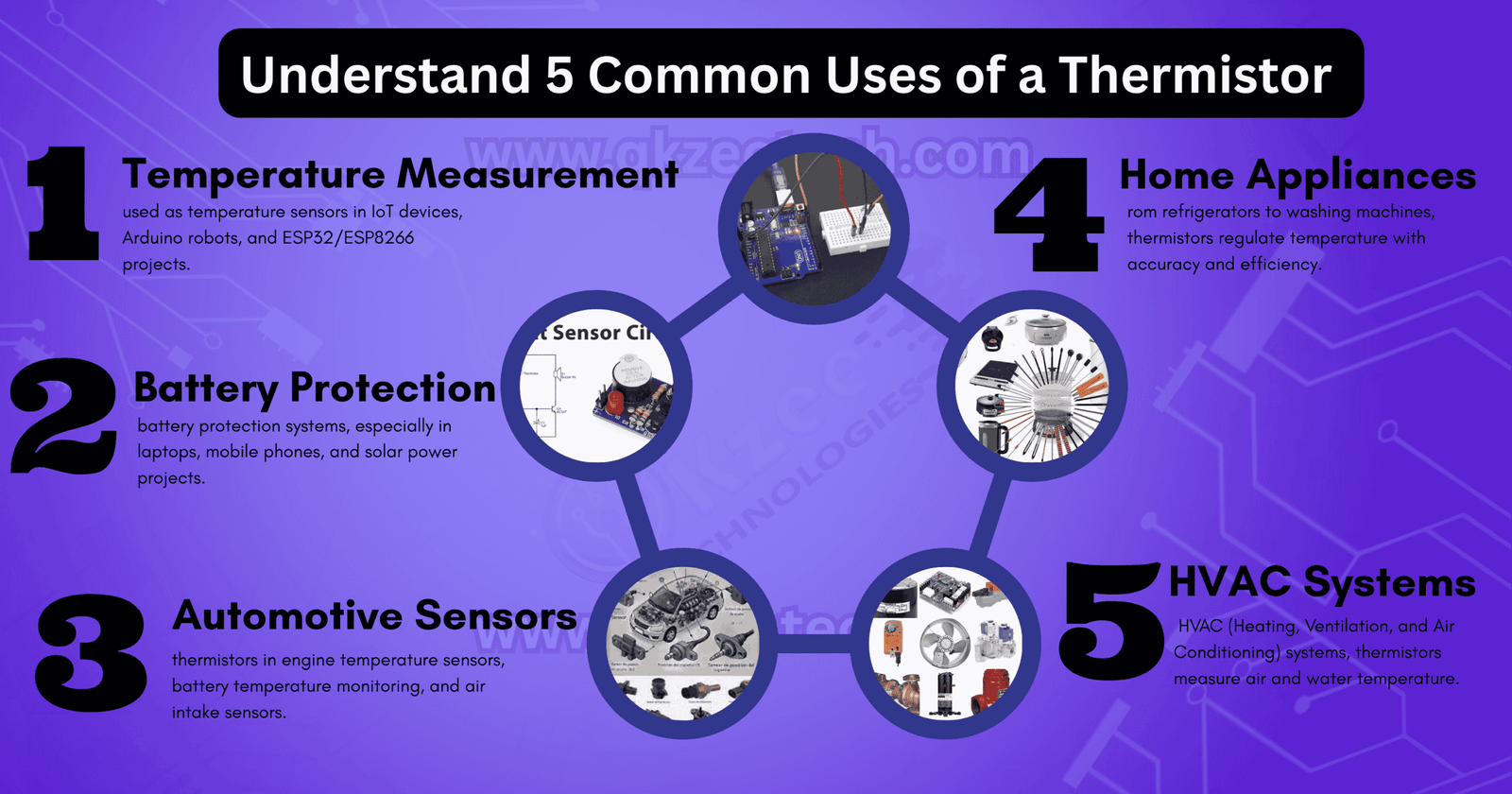How to Understand 5 Common Uses of a Thermistor and How It Works
How to Understand 5 Common Uses of a Thermistor and How It Works
Introduction – What Is a Thermistor and Why It’s Used
A thermistor is a small but powerful component used in almost every electronics engineering project. Whether you’re working on students projects, final year projects, or industrial automation systems, the thermistor is essential for temperature sensing and control.
At QKZee Technologies, located on Hall Road Lahore, engineers, students, and hobbyists use thermistors in IoT-based temperature sensors, automation systems, and biomedical devices. In Pakistan, QKZ Tech and Qasim Shahzad are well-known for guiding students on how to use and how to make thermistor-based circuits with the best price and high accuracy.
Working Principle – NTC vs PTC Thermistors
The thermistor working principle is based on the change in electrical resistance with temperature. The word thermistor comes from “thermal” and “resistor.” There are two main types:
1. NTC Thermistor (Negative Temperature Coefficient)
When the temperature increases, the resistance decreases. These are ideal for temperature sensing, battery management, and Arduino projects.
2. PTC Thermistor (Positive Temperature Coefficient)
Here, resistance increases as temperature rises. They’re used for overcurrent protection, industrial automation, and HVAC systems.
Think of the thermistor as a smart resistor — it “feels” the temperature and changes its resistance accordingly. This feature makes it one of the best sensors for engineering projects in Lahore and Pakistan.
Top 5 Uses of a Thermistor
Let’s explore five common uses of thermistors that make them vital in both DIY projects and industrial electronics.
1. Temperature Measurement in IoT and Arduino Projects
Thermistors are most commonly used as temperature sensors in IoT devices, Arduino robots, and ESP32/ESP8266 projects.
For example, in a final year project on smart home automation, a thermistor can detect room temperature and send data to Firebase, Blynk IoT, or Thingspeak for real-time monitoring.
Circuit Example:
Connect the thermistor to an Arduino analog pin through a resistor.
Read the voltage changes as temperature varies.
Use the Steinhart-Hart equation or a simple calibration method to convert readings to Celsius.
Software & Hardware Required:
Arduino UNO or ESP32 board
NTC Thermistor (10kΩ)
10kΩ resistor
Breadboard, jumper wires, and code using Arduino IDE
2. Battery Protection in Electronic Devices
Thermistors play a key role in battery protection systems, especially in laptops, mobile phones, and solar power projects.
When batteries overheat, the thermistor detects temperature rise and sends a signal to stop charging — preventing damage or explosion.
At QKZee Technologies Lahore, engineers design battery management systems (BMS) using thermistors for university projects and industrial power modules.
3. HVAC Systems and Climate Control
In HVAC (Heating, Ventilation, and Air Conditioning) systems, thermistors measure air and water temperature. They maintain a perfect balance between comfort and energy efficiency.
How it Works:
An NTC thermistor detects ambient air temperature.
The system adjusts heating or cooling accordingly.
This application is widely used in industrial projects and automation systems across Pakistan, especially for smart energy solutions at QKZee Tech Lahore.
4. Automotive Sensors
Modern vehicles use thermistors in engine temperature sensors, battery temperature monitoring, and air intake sensors.
These sensors ensure that the engine operates at an optimal temperature. If it overheats, the thermistor signals the Electronic Control Unit (ECU) to take corrective action.
Students projects in Lahore often replicate this system for automotive IoT monitoring, creating smart dashboards using Raspberry Pi and ESP32.
5. Home Appliances and Consumer Electronics
From refrigerators to washing machines, thermistors regulate temperature with accuracy and efficiency.
When the temperature reaches a set limit, the thermistor automatically triggers heating or cooling mechanisms. This makes them vital in home automation and smart energy-saving devices.
At QKZee, students learn how to use thermistors in designing IoT-enabled smart home systems, making these DIY projects both affordable and practical.
Advantages of Thermistors
Thermistors offer several benefits that make them popular in engineering projects:
High sensitivity and fast response time.
Compact size, ideal for embedded systems.
Low cost – best price for student projects in Pakistan.
Accurate and reliable readings.
Because of these benefits, thermistors are widely used by electrical engineers and electronics engineering students in final year projects at universities in Lahore.
Limitations of Thermistors
Despite their advantages, thermistors also have some limitations:
Limited temperature range compared to thermocouples.
Non-linear output, requiring calibration.
Affected by self-heating during long use.
Still, for student projects near Hall Road Lahore, thermistors remain the most cost-effective and easy-to-use temperature sensors.
Conclusion – Choosing the Right Thermistor for Your Project
Selecting the right thermistor depends on your project’s purpose. For IoT and Arduino projects, an NTC thermistor is ideal. For industrial automation or overcurrent protection, a PTC thermistor works better.
If you’re a student in Lahore, Pakistan, looking for the best price for FYP components, visit QKZee Technologies on Hall Road. Qasim Shahzad and his expert team offer consultation for final year projects, circuit design support, and electronics parts for all engineering and science projects.
Where to Buy Your Electronics Components
Looking for affordable components for this Arduino project? Check out QKZee Technologies, an online shop in Lahore, Pakistan, offering the best components for students and DIY projects. Whether you’re looking for sensors, modules, or other electronics at a cheap price, they’ve got it all. Visit them at QKZeeTech.
1. What is the main function of a thermistor?
It measures temperature by changing resistance with temperature variation.
2. What is the difference between NTC and PTC thermistors?
NTC decreases resistance with temperature, while PTC increases it.
3. Can thermistors be used with Arduino or ESP32?
Yes! You can easily connect an NTC thermistor to an Arduino or ESP32 for IoT temperature monitoring.
5. What are thermistors used for in daily life?
They’re used in home appliances, automobiles, HVAC systems, and battery protection circuits.
4. Where can I buy thermistors in Lahore?
visit QKZee Technologies Hall Road Lahore, or contact QKZee Technologies for genuine parts and student-friendly prices,
You can buy them at QKZee Technologies, Hall Road Lahore, at the best price with complete project guidance.




